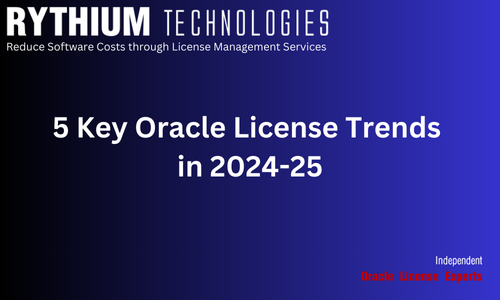5 Key Oracle License Trends in 2024-25 are discussed in this article.
Introduction
As we move through 2024 and into 2025, Oracle is aggressively advancing its licensing strategies, aiming to maximize revenue while retaining its customers in an increasingly competitive technology landscape. Oracle’s push to renew Oracle Unlimited License Agreements (ULAs), bundle its cloud infrastructure services, and sell on-premises Exadata Cloud@Customer solutions are just some of the methods it employs. Moreover, the company has intensified efforts in license audits, especially focusing on Oracle Java and software compliance.
These trends indicate that customers relying on Oracle technologies are expected to spend significantly more unless they take proactive steps to optimize their license strategies. Below, we will explore the five key Oracle license trends that will define 2024-25, and how they will impact Oracle’s customers.
1. Aggressive Oracle ULA Renewals
Oracle’s Unlimited License Agreement (ULA) has long been a tool used by enterprises to manage their Oracle software usage across the organization. A ULA allows customers to deploy unlimited instances of specific Oracle products during a set time frame, typically between three to five years. At the end of the ULA period, customers must either renew or certify their Oracle usage.
In 2024-25, Oracle is pushing aggressively for Oracle ULA renewals. By doing so, the company locks in customers for another multi-year period, ensuring that their business remains reliant on Oracle’s software products. However, the renewal process can be challenging for customers who may not need the same level of product usage as they did when initially signing the ULA. Some businesses find that they no longer need the vast deployment capabilities, making renewal less attractive.
Renewal can also lead to significant cost increases, particularly if customers are not able to optimize their Oracle usage. Oracle’s License Audit Services play a critical role here, as they may conduct audits before ULA expiration to ensure the customer is in compliance. An Oracle license audit can sometimes expose overuse, forcing companies into costly renewal terms to avoid penalties.
To navigate this, businesses need to prepare for their Oracle ULA expirations well in advance. By evaluating their current Oracle deployment, usage trends, and future needs, customers can engage in meaningful negotiations and even consider certifying rather than renewing if they have optimized their deployment efficiently.
2. Bundling OCI Cloud with Oracle ULA
Alongside Oracle ULA renewals, Oracle is heavily promoting its Oracle Cloud Computing services, particularly OCI Cloud (Oracle Cloud Infrastructure), as part of ULA negotiations. Oracle’s cloud strategy revolves around enticing customers to migrate their existing on-premises workloads to its OCI Cloud platform, combining the flexibility of ULA with cloud adoption.
This bundling strategy benefits Oracle in two ways:
- It encourages existing ULA customers to transition to Oracle’s cloud services rather than competing cloud platforms such as AWS or Azure.
- It locks customers into Oracle’s ecosystem, making it more challenging and costly to switch to other technologies later on.
From a customer perspective, bundling Oracle Cloud Computing services with a Oracle ULA can bring significant advantages in terms of scalability, reduced capital expenditure, and a simplified pricing model. However, it also increases reliance on Oracle’s cloud ecosystem, which can become expensive over time if not carefully managed.
One key consideration for customers is the need to assess whether the benefits of OCI Cloud outweigh those of competing platforms. While Oracle is pushing cloud adoption through its bundled offerings, customers should conduct a thorough analysis of their cloud requirements. They should evaluate performance, scalability, cost-effectiveness, and support before fully committing to Oracle’s infrastructure.
In many cases, proactive cloud migration planning can prevent long-term lock-in and allow businesses to leverage multi-cloud strategies to avoid being overly dependent on any single vendor.
3. Expansion of Oracle Exadata Cloud@Customer
Another significant trend in Oracle’s sales strategy is the expansion of Oracle Exadata Cloud@Customer. This offering is a hybrid cloud solution that allows customers to run Oracle’s high-performance Exadata systems in their own data centers while connecting seamlessly to Oracle Cloud Computing. It provides the performance benefits of Oracle Exadata with the flexibility of cloud subscription pricing, without having to fully migrate data to the public cloud.
For many large organizations with strict data sovereignty, security, or compliance requirements, Exadata Cloud@Customer offers a middle ground, combining the performance of Oracle’s flagship database system with cloud economics.
However, as with any Oracle product, licensing costs can add up quickly, especially if the customer’s deployment grows beyond the initial expectations. Many customers find themselves subject to unexpected licensing audits under Oracle’s License Audit Services, particularly when using hybrid cloud or complex on-premise/cloud systems.
Oracle is promoting Exadata Cloud@Customer as part of its broader Oracle Cloud Computing portfolio, pushing this solution to organizations that might be hesitant to move entirely to the cloud due to regulatory or latency concerns. By adopting this service, customers can reduce hardware ownership costs and benefit from cloud-like flexibility.
But before adopting Exadata Cloud@Customer, it is essential for organizations to conduct a full cost-benefit analysis, taking into account both the infrastructure and potential long-term Oracle license cost increases, particularly as Oracle’s Oracle License Audit Services become more frequent.
4. Heightened Focus on Java License Audits and Java License Changes
In recent years, Oracle has increased its focus on Oracle Java licensing. Previously available for free, Oracle has introduced a Java license change that requires businesses to purchase licenses for Oracle Java SE (Standard Edition) under specific circumstances. This change has caught many organizations off-guard, particularly those that have built applications or systems heavily dependent on Oracle Java.
In 2024-25, Oracle is expected to conduct more frequent audits focusing on Oracle Java usage to ensure compliance with its new licensing rules. The Java license change is part of Oracle’s broader effort to monetize one of its most widely used technologies, and organizations that do not comply with the new licensing model could face significant penalties.
In the context of an Oracle license audit, Oracle Java usage often goes unnoticed by IT teams, as Java has historically been free for most non-commercial uses. Now that the Java license change is in effect, Oracle is leveraging its License Audit Services to scrutinize Java deployments, ensuring that businesses are paying for the commercial use of Java.
To avoid non-compliance and unexpected costs, organizations must:
- Conduct a thorough inventory of their Oracle Java usage.
- Understand the Java license change and its impact on their operations.
- Transition to licensed versions of Oracle Java where necessary.
Being proactive in managing Oracle Java licenses will help businesses avoid surprise fees during an audit and allow them to optimize their Java-related expenses.
5. Increased Oracle License Audits and LMS Activity
Oracle’s License Management Services (LMS) department, which is responsible for conducting software audits, is expected to intensify its audit activity throughout 2024 and 2025. Oracle has recognized audits as a critical revenue stream and has ramped up efforts to identify non-compliance across its customer base. This includes increased scrutiny of OCI Cloud, Oracle Java, and on-premises software licenses.
An Oracle license audit can be a significant event for a business, potentially uncovering gaps in compliance that lead to costly penalties. Audits may focus on a wide range of products, including those deployed through a Oracle ULA, in hybrid environments using Oracle Cloud Computing, or on legacy on-premises systems.
To mitigate risk, businesses need to be proactive:
- Regularly assess their software usage across all Oracle products.
- Work with Oracle’s License Audit Services to address potential compliance gaps.
- Develop and implement a comprehensive license optimization strategy that includes periodic internal audits to preempt any official Oracle audits.
By staying ahead of Oracle’s auditing trends, businesses can avoid large unexpected fees and achieve better Oracle license optimization.
Conclusion
In 2024-25, Oracle is clearly focusing on generating more revenue through a combination of Oracle ULA renewals, cloud bundling, Java audits, and the expansion of OCI Cloud and Oracle Exadata Cloud@Customer. Customers will face increasing pressure to spend more on Oracle products unless they take a proactive approach to license optimization.
Key areas to watch include the Oracle Java license change, bundling of cloud services with ULAs, and the intensification of Oracle License Audit Services. Organizations must prioritize Oracle license optimization to mitigate the potential cost increases associated with these trends. By staying informed and taking the right steps, businesses can navigate Oracle’s complex licensing landscape while minimizing risk and maximizing the value of their Oracle investment.


